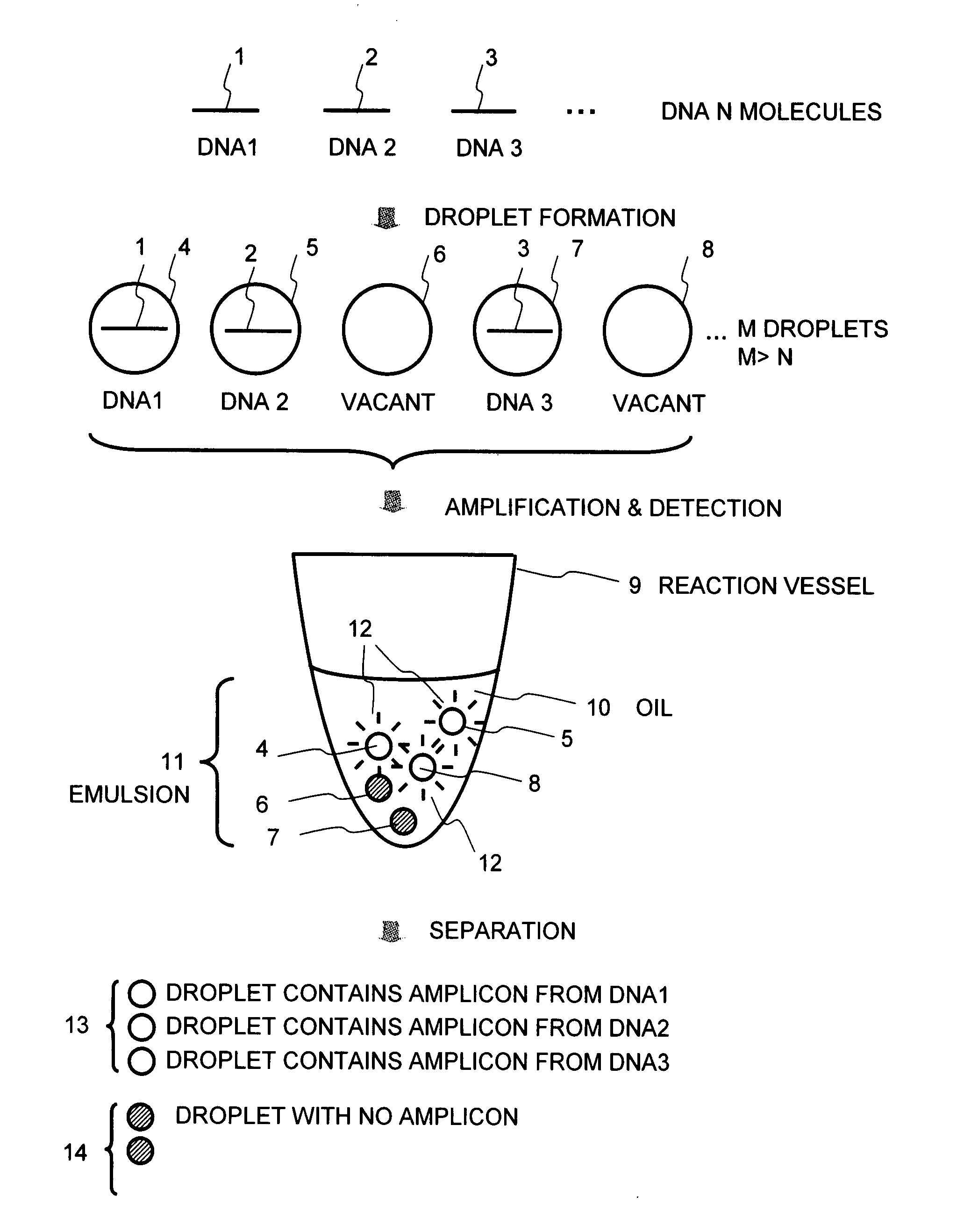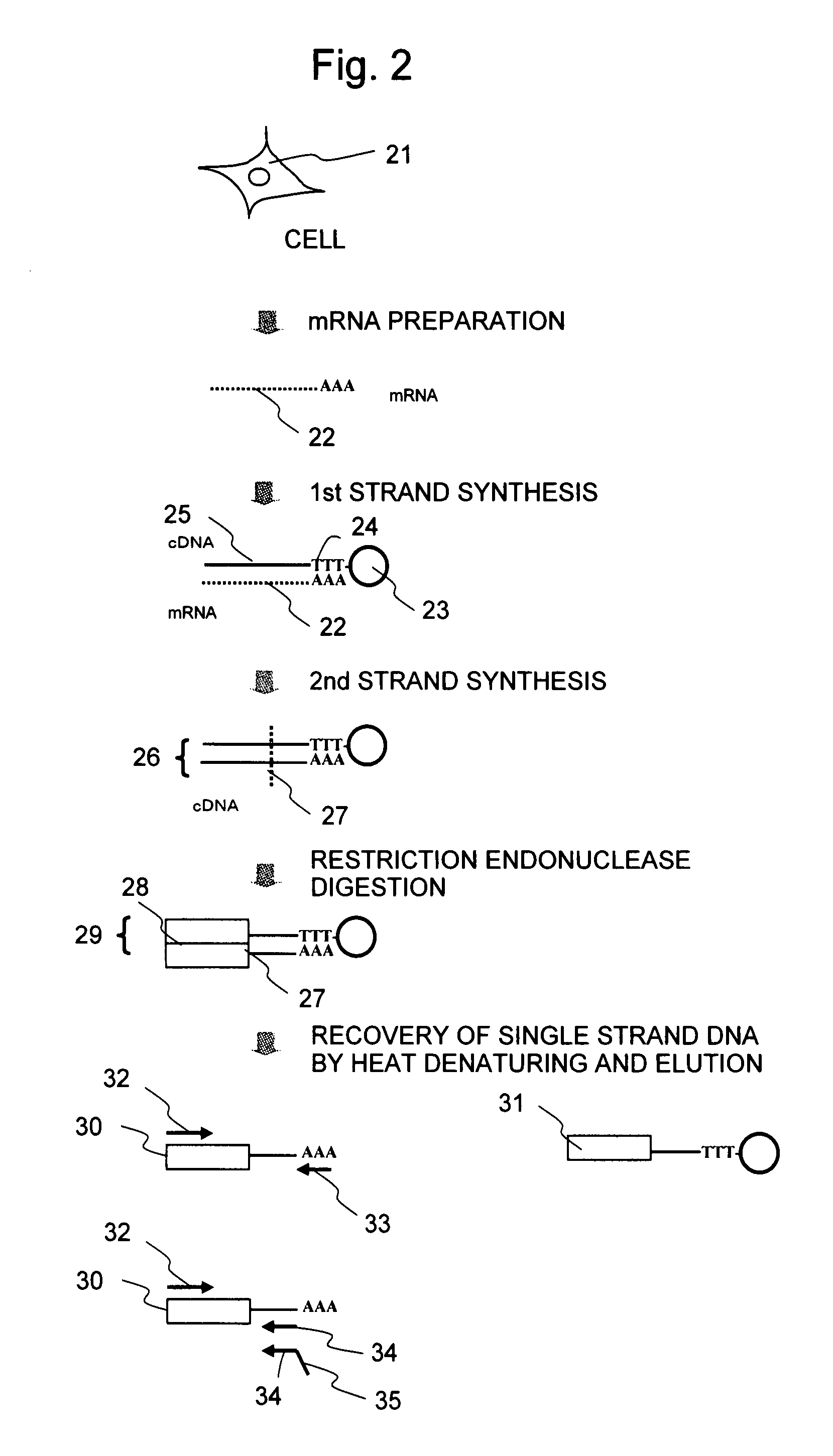Method and apparatus for sample preparation
a gene analysis and sample technology, applied in biochemistry apparatus and processes, specific use bioreactors/fermenters, after-treatment of biomass, etc., can solve the problems of reducing the reaction efficiency of a solid phase, reducing the reaction efficiency of a single phase, and not providing expected measurement samples, so as to save costs and labor costs. , the effect of preventing sample loss
- Summary
- Abstract
- Description
- Claims
- Application Information
AI Technical Summary
Benefits of technology
Problems solved by technology
Method used
Image
Examples
example 1
[0052]In this Example, the preparation of an emulsion containing agarose by stirring in oil is illustrated as an example.
[0053]FIG. 1 shows the basic concept of the present method. A sample solution containing analyte DNA molecules 1 to 3 is fractionated into small droplets 4 to 8, wherein the number M of the droplets is greater than the total number N of the DNA molecules. As a result, the droplets 4, 5, and 7 containing the DNA and the droplets 6 and 8 containing no DNA are formed. The droplets 4 to 8 are dispersed into oil 10 in a reaction vessel 9 to form an emulsion 11. This emulsion containing the droplets is subjected to, for example, PCR amplification. Then, the presence or absence (amount) of an amplicon obtained in each droplet is detected by fluorescent detection using an intercalator or the like to make a separation between a droplet 13 that contains an amplicon from each of the DNAs 1 to 3, from which fluorescence 12 is detected, and a droplet 14 with no amplicon, from ...
example 2
Shape of Reaction Vessel
[0091]In this Example, the shape of a reaction vessel comprises a plate in which mutually separated small reaction cells are arranged.
[0092]This Example will be described with reference to FIGS. 8 to 10. As shown in FIG. 8, a plate 80 is provided with a large number of wells 83 for accommodating individual small droplets 81 and 82. The wells 83 are two-dimensionally arranged, as shown in FIG. 9, to constitute the plate 80. The droplet may be contained directly in the well 83 and covered with a hydrophobic solution 84 or may be contained in the hydrophobic solution 84 in the well 83.
[0093]In this case, the hydrophobic solution 84 is used for the purpose of forming an emulsion and further functions to prevent water evaporation from the reaction solution, to keep the shape of the droplets spherical, and to prevent the adhesion between the gel and the vessel surface during the isolation of the gel.
[0094]The droplets 81 and 82 must be separated mutually. However, ...
example 3
[0098]In this Example, another method for producing small droplets will be illustrated.
[0099]This Example will be described with reference to FIG. 11. In this Example, an ink jet unit 100 is used in droplet formation. The ink jet unit 100 comprises a tank 101 for storing a solution for preparation of droplets 103 and a nozzle 102 for spouting the formed droplets. The nozzle spouts a predetermined amount of a reaction solution by momentarily heating the reaction solution. The droplets 103 are placed in a vessel 105 so that the droplets 103 are directly spouted or allowed to fall into a hydrophobic solution 104. The droplets 103 are spouted or allowed to fall into the hydrophobic solution 104 to thereby prepare an emulsion 106.
[0100]This Example is suitable for controlling the size and quantity of the droplets and is particularly suitable for preparing approximately 0.5 pl to 10 pl droplets (approximately 10 μm to 30 μm in diameter). When the droplets are directly spouted into the hyd...
PUM
| Property | Measurement | Unit |
|---|---|---|
| diameter | aaaaa | aaaaa |
| diameter | aaaaa | aaaaa |
| temperatures | aaaaa | aaaaa |
Abstract
Description
Claims
Application Information
 Login to View More
Login to View More - R&D
- Intellectual Property
- Life Sciences
- Materials
- Tech Scout
- Unparalleled Data Quality
- Higher Quality Content
- 60% Fewer Hallucinations
Browse by: Latest US Patents, China's latest patents, Technical Efficacy Thesaurus, Application Domain, Technology Topic, Popular Technical Reports.
© 2025 PatSnap. All rights reserved.Legal|Privacy policy|Modern Slavery Act Transparency Statement|Sitemap|About US| Contact US: help@patsnap.com



